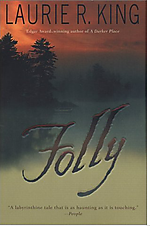Folly by Laurie King
A smart character-driven novel of psychological suspense
2001
Can creative work heal?
That’s the question raised by this novel in the person of Rae Newborn, a woman who’s been through a few things. She’s a 50+-year-old woman, woodworker, a creator once of “glorious pieces of usable furniture.” She’s also a survivor of postpartum depression, of thirty-plus subsequent years of intermittent depression, of three suicide attempts (complete with scars), as well as multiple psychiatric hospitalizations. And, as if this weren’t quite enough, a mere fifteen months prior to the novel’s opening she’s suffered the loss of her husband and young daughter, and she’s undergone a terrifying assault.
All that sorrow is in the background—what is sometimes called the back story. The front story—the first page—finds Rae having just arrived on Folly, an island in the San Juan chain which she’s inherited from her grandfather by way of her great-uncle, Desmond.
Desmond, now deceased, was a WWI veteran, enlisting in the British Army and serving three years as a foot soldier before returning home to eventually become the family’s black sheep, the family secret, a disavowed relative with a kind of shameful injury which Rae only begins to unravel as an adult: “what Desmond left on the Western Front was a portion of his mind; that was the shame for which his family could not forgive him.”
Not surprisingly, Rae feels a kinship with Desmond. She’s drawn to this island and to the ruins of his house there, also called Folly, a house he built with his own hands but which has since burned down to the foundation.
What remains? Two stone towers, the chimney, the foundation, and seven decades of vegetation which, in an image reminiscent of the briar thicket in Sleeping Beauty, has grown over the foundation.
Vine maple, red alder, huckleberry, and madrone had found footholds in the rich humus that resulted from the return of a wooden building’s component parts to nature; nettle, blackberry, thistle, and wild rose wrapped affectionately around the towers and tore at Rae’s skin and clothes. . .
Rae comes to the island with a plan to clear back the vegetation and rebuild the house from its foundation. A plan to follow Desmond’s lead and engage in what she calls, “recovery through hard labor.”
(Note: at one point early on she dumps all her psych meds into the cove. A nice symbolic gesture and it works I think in a kind of symbolic fictional way, but in life I’d be, Rae, I respect what you’re trying to do here, but hold on here a minute, you’ve been on these meds a while now, you need to take this slow, try this as a slow taper, an experiment of sorts, and preferably under medical supervision. That said, the tossing has a certain fictional power that a taper just wouldn’t quite.)
And so she begins. She sets up her tent, and an outdoor workspace, complete with a workbench and a French coffee press. She begins to build. And things happen. Among them, rustling and whisperings in the woods. Real? Imagined? It’s part of the mystery that unfolds. A gradual answer to the question posed by the Tom Wilkinson character in the film, Michael Clayton: What if this is not just madness?
So there’s a mystery that unfolds. Suspense. Tension. There’s also a clear and tangible sense of rebuilding and recovery.
In Judith Herman’s Trauma and Recovery she names three stages of recovery:
Establishment of safety
Remembrance and mourning
Reconnection to ordinary life
All three stages are well-represented here, and woven together skillfully. A sense of safety that grows as the structure of the house does. The acts of remembrance and mourning which arise for Rae, inevitably, amidst the quiet of the island, and which emerge in flashbacks, journal entries, and letters. And, finally, a sense of reconnection—to the work of the house, to ordinary pleasures, to a small community of people which she comes to know, to her elder daughter, and to the landscape of the island itself.
A landscape which—I couldn’t help noticing—encompasses all seven of the landscape archetypes named by Messervy in the Magic Land. Sea and Island of course. And Sky. But, also, a Cave, a Cove or Harbor where Rae swims, a Mountain (also called the Height of Folly) which she climbs on those rare occasions she wants to get cell phone reception, and a Promontory on which she often sits to drink her coffee in the early morning. Also, a spring, a pool, and trees—fir and alder and madrone. I suspect that all of these elements contribute to a sense that this island of Folly—also called Sanctuary—evokes an entire world.
_____________________________________________________________
See also Laurie King’s website
for many informative and amusing things, among them—–
A brief description of Folly as, “The book that nearly emptied Random House, New York, as half the staff came perilously near to deciding that if Rae Newborn could go to an island and rebuild an old house, why couldn’t they? After all, they didn’t begin with her problems, did they?”

